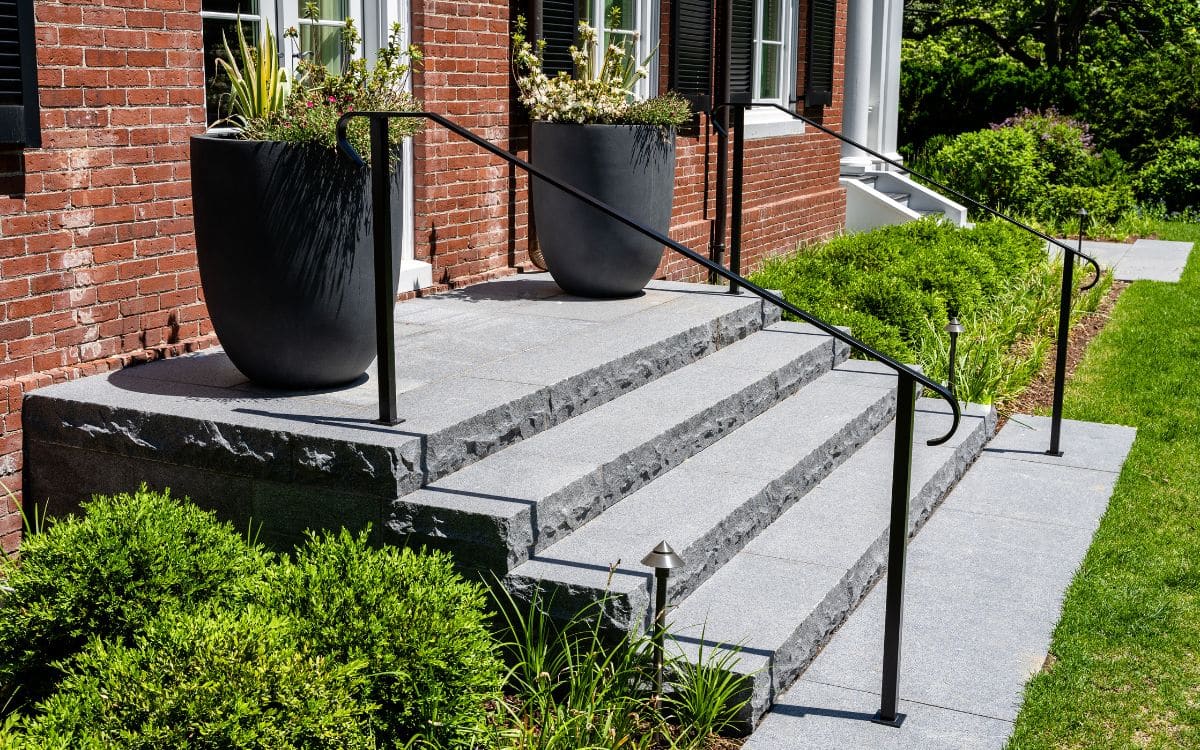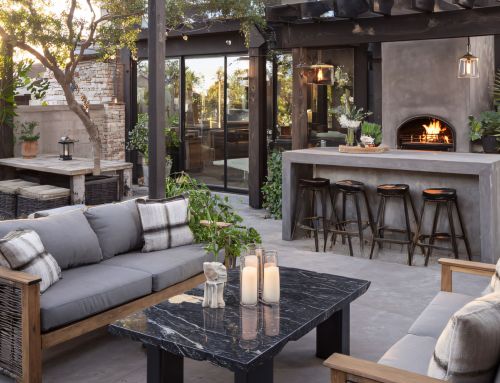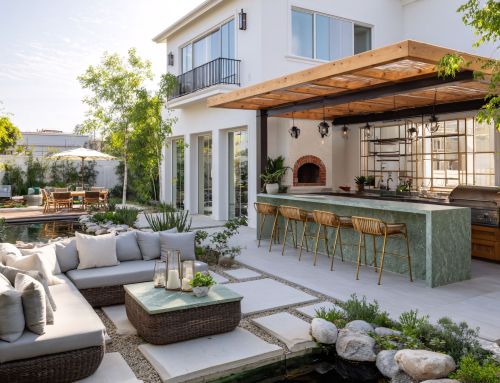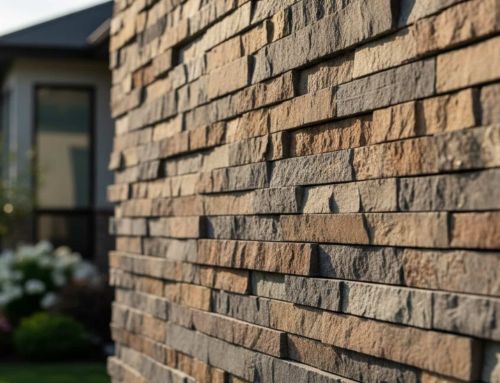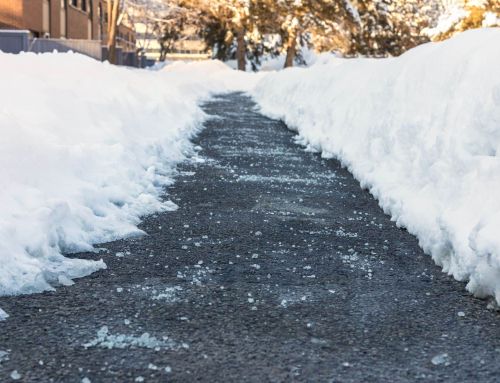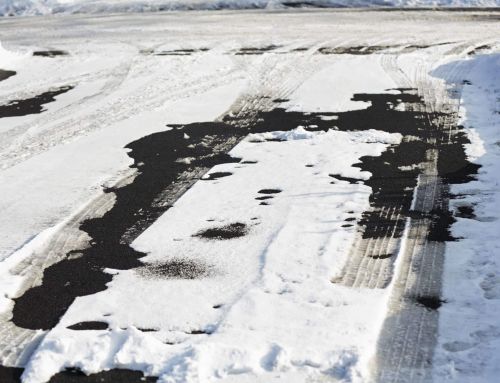Every year, homeowners upgrade worn-out concrete outdoor steps with durable, eye-catching materials that boost safety and curb appeal. Well-designed landscape steps not only improve access but can also add significant value to your home. From natural stone to textured concrete, modern options blend function with beauty, creating a welcoming path that complements your property. Thoughtful step design can also improve drainage and reduce erosion on sloped yards.
Whether you’re tackling a sloped yard or creating a new entryway, the right materials and design are essential, especially in New England’s tough climate. This guide covers everything you need to build steps that are safe, stylish, and built to last.
Understanding Outdoor Steps
Before choosing materials or finalizing your design, it helps to understand how steps are built for both safety and comfort. A well-designed step system includes several key parts:
- Treads: The flat surfaces where you step. These should be at least 11 inches deep for stability.
- Risers: The vertical sections between each tread. A maximum height of 7 inches is recommended for comfortable climbing.
- Landings: Flat areas that offer rest and transition, especially useful after 12–15 steps or at a change in direction.
- Foundation: The base that supports your steps. This usually includes compacted crushed stone or concrete footings, especially in areas with freezing temperatures.
By understanding these components, you’ll be better prepared to plan safe, lasting steps that suit your space and climate.
Natural Stone: The Premium Choice
When it comes to combining unmatched durability with timeless beauty, natural stone remains the gold standard for landscape steps. Granite steps offer exceptional value despite higher initial costs, with many installations lasting over 100 years with minimal maintenance.
Granite
Granite steps offer unmatched durability and stability, with each piece weighing between 400 and 1,600 pounds. Popular types like Caledonia, Barre, and Deer Isle granite feature timeless gray or dark tones and consistent coloring. Installed dry without mortar, granite steps naturally adjust to freeze-thaw cycles, preventing cracks and maintaining long-term structural integrity.
Bluestone
Bluestone is a durable, budget-friendly option for natural stone steps. It’s known for its textured, slip-resistant surface, especially full-color bluestone with natural cleft finishes that provide excellent traction even when wet. Pennsylvania bluestone offers a more uniform blue-gray tone, while Connecticut varieties feature a mix of colors for a more rustic look.
Flagstone
Flagstone is another natural, affordable option for outdoor steps. While 2-inch flagstone is suitable for walkways, structural steps require at least a 3-inch thickness to support weight safely. The irregular shapes and earthy colors make flagstone a great choice for a more organic, informal appearance.
Wood Steps: Versatile and Affordable
Wood steps offer a natural look and flexible design options at a reasonable cost. Their success depends on choosing the right type of wood and proper installation.
Pressure-Treated Lumber
Pressure-treated lumber is a common choice due to its affordability and decent lifespan. Southern Yellow Pine treated for ground contact typically lasts 15 to 25 years with regular maintenance. The treatment process pushes preservatives deep into the wood, helping it resist rot, insects, and moisture.
Premium Hardwoods
Hardwoods like black locust and white oak provide excellent long-term performance. 6-inch square locust beams can last 40 to 50 years in direct ground contact without chemical treatments. White oak offers similar strength and longevity, though it comes at a higher price.
Composite Materials
Composite steps are made from a mix of wood fibers and recycled plastics. They offer a low-maintenance alternative that resists rot, insects, and moisture while keeping the look of natural wood. These are ideal for homeowners who want durability without ongoing upkeep.
Installation Tips
For stability, each wood or composite beam should be anchored with 24-inch galvanized rebar driven through pre-drilled holes. Use three rebars per step. Be sure to excavate behind each step and backfill with gravel to promote drainage and prevent shifting.
Concrete and Masonry Solutions
Concrete and masonry steps offer a wide range of design possibilities while remaining durable and cost-effective. Whether you prefer modern finishes or traditional brickwork, these materials provide strong, long-lasting solutions for any landscape.
Precast Concrete Steps
Precast concrete steps are factory-made for consistency and easy installation. Available in standard sizes, they can often be installed in a single day. High-quality precast units feature built-in reinforcement and textured, slip-resistant surfaces for added safety.
Poured-in-Place Concrete
Poured-in-place concrete offers complete design flexibility. This method allows for custom shapes, curved layouts, built-in planters, and decorative elements. Stamped concrete can mimic the look of natural stone, brick, or wood at a lower cost.
Reinforcement and Control Joints
Proper reinforcement is essential to prevent cracking and ensure long-term durability. Horizontal steel bars should be placed within the step treads, with vertical bars connecting the steps for added structural strength. Control joints help guide cracking to specific locations, minimizing random surface damage.
Brick and Masonry Steps
Brick and masonry create a classic, timeless appearance and work well for homes with matching exterior materials. Clay bricks require proper mortar and good drainage to withstand freeze-thaw cycles, making them ideal for milder climates or well-drained areas.
Landscape Step Design Tips
Designing effective and attractive landscape steps starts with evaluating your home’s architecture, terrain, and functional needs. The goal is to create steps that are both beautiful and safe while blending seamlessly with your surroundings.
Match Your Home’s Architecture
Steps should reflect the style and scale of your home. Traditional homes pair well with materials like natural stone or brick that echo existing features. Modern homes often suit clean-lined concrete or metal accents. The width of your steps should also feel proportionate, as larger homes call for wider, more spacious steps.
Consider Your Slope
The slope of your yard affects how steps should be spaced and constructed:
- Gentle slopes (under 15 percent) can use widely spaced steps 3 to 4 feet apart, often with built-in landings.
- Moderate slopes (15 to 30 percent) require more traditional step construction with 6 to 7-inch risers and may include switchbacks.
- Steep slopes (over 30 percent) typically need terracing, multiple landings, and may require input from a landscape engineer.
Prioritize Safety and Drainage
To ensure long-term performance and safety, all step systems should include:
- Slip-resistant surfaces to reduce fall risk
- Adequate lighting for nighttime visibility
- Handrails were required by local building codes
- Proper drainage to prevent water buildup and ice formation
Well-designed steps not only improve accessibility but also enhance the beauty and value of your outdoor space.
Professional Installation vs. DIY
Some step projects are great for DIYers, especially those using pressure-treated wood, concrete pavers, or small flagstone pieces. These materials are manageable, and the techniques are relatively simple with the right tools and planning.
However, projects involving heavy granite steps, complex designs, or structural needs are best left to professionals. They have the equipment and expertise to ensure proper foundation work, precise installation, and safety. Professional installations often include warranties on both materials and workmanship, offering added peace of mind.
Maintenance and Longevity
Different materials require varying maintenance levels throughout their lifespan.
- Natural stone needs minimal maintenance like annual inspection, occasional cleaning, and joint maintenance. Granite can last 100+ years with virtually no upkeep beyond basic cleaning.
- Wood steps require annual inspection, cleaning, and refinishing every 2-3 years. Hardware should be checked and tightened regularly. Proper maintenance extends life significantly.
- Concrete and masonry need periodic sealing, crack monitoring, and joint maintenance every 5-10 years, depending on conditions.
Seasonal care includes proper snow removal techniques, appropriate de-icing products, and spring damage assessment.
Cost Planning and Value
Understanding the total cost of ownership is key to making smart choices for your landscape steps. Initial installation costs vary: wood steps typically cost between $200 and $500 per step, concrete steps range from $300 to $800, and natural stone steps can cost $500 to $1,500 per step.
While natural stone, such as granite, has a higher upfront cost, it offers unmatched longevity with minimal maintenance, often lasting over 100 years. Over time, this makes it one of the most cost-effective options. High-quality entrance steps can also increase your home’s value by 3 to 8 percent, with natural stone providing the greatest return.
Conclusion
Landscape steps do more than connect spaces. They elevate the beauty, safety, and value of your property. Whether you choose natural stone, wood, concrete, or composite materials, thoughtful design and proper installation make all the difference. With the right planning and materials, your outdoor steps can offer decades of reliable performance while enhancing curb appeal in every season.
Ready to upgrade your outdoor steps? Old Station Outdoor & Landscape Supply carries a wide selection of premium hardscape materials, including granite, bluestone, flagstone, and precast concrete steps. Our expert team can help you choose the right products for your property, style, and slope. Visit our Norton showroom or contact us today to get started on a durable, beautiful step installation that’s built to last.
FAQs
How many landscape steps do I need?
Divide your total vertical rise by 7 inches (optimal step height) to determine the number of steps needed. For example, a 35-inch rise would require 5 steps, especially when connecting to a patio, deck, or outdoor center feature such as a seating area or fire pit.
What is a garden step?
A garden step is a landscaping feature that provides a safe passage through sloped terrain while integrating naturally with plantings and outdoor design elements. They stand as both functional and decorative features.
Can I install the steps myself?
Simple wood steps with basic frame construction are DIY-friendly, but stone steps requiring heavy equipment and precise placement should be professionally installed. Explore professional options for double-wide installations that enhance functionality with sleek designs, connecting your deck to outdoor steps with proper step treads.
What are step treads, and why do they matter?
Step treads are the horizontal walking surfaces where you place your feet. Quality treads provide slip resistance and durability, especially important for safety on outdoor installations.
Can I connect steps directly to my deck?
Yes, steps can seamlessly connect to your deck using matching materials and proper structural support. Professional installation ensures proper frame connections and code compliance for deck-to-ground transitions.

